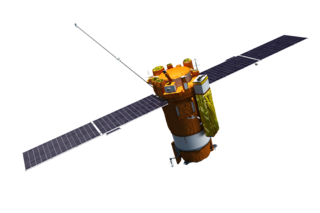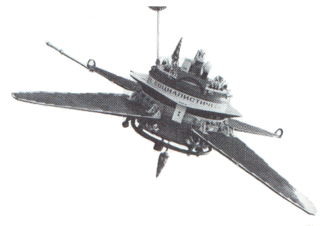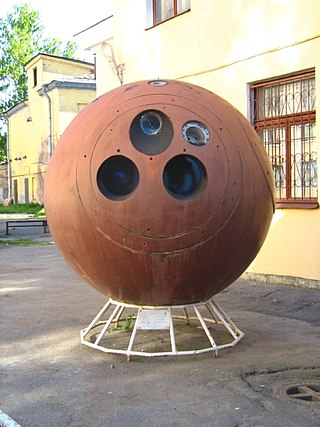Venera 2MV-1 No.2, also known as Sputnik 20 in the Western world, was a Soviet spacecraft, which was launched in 1962 as part of the Venera programme. Due to a problem with its upper stage it failed to leave low Earth orbit, and reentered the atmosphere a few days later. It was the second of two Venera 2MV-1 spacecraft, both of which failed to leave Earth orbit. The previous mission, Venera 2MV-1 No.1, was launched several days earlier.

Mars 2MV-4 No.1 also known as Sputnik 22 in the West, was a Soviet spacecraft, which was launched in 1962 as part of the Mars programme, and was intended to make a flyby of Mars, and transmit images of the planet back to Earth. Due to a problem with the rocket which launched it, it was destroyed in low Earth orbit. It was the first of two Mars 2MV-4 spacecraft to be launched, the other being the Mars 1 spacecraft which was launched eight days later.
Venera 2MV-2 No.1, also known as Sputnik 21 in the West, was a Soviet spacecraft, which was launched in 1962 as part of the Venera programme, and was intended to make a flyby of Venus. Due to a problem with the rocket which launched it, it failed to leave low Earth orbit, and reentered the atmosphere a few days later. It was the second Venera 2MV-2 spacecraft, both of which failed to leave Earth orbit.

Gonets is a Russian civilian low Earth orbit communications satellite system. It consists of a number of satellites, derived from Strela military communications satellites. The first two satellites, which were used to test and validate the system, were launched by a Tsyklon-3 launch vehicle from the Plesetsk Cosmodrome on 13 July 1992, and were designated Gonets-D. The first operational satellites, designated Gonets-D1, were launched on 19 February 1996. After launch, the first three satellites were given military Kosmos designations, a practice which was not continued with the other satellites.

Koronas-Foton, also known as CORONAS-Photon, was a Russian solar research satellite. It was the third satellite in the Russian CORONAS programme, and part of the international Living With a Star programme. It was launched on 30 January 2009, from Site 32/2 at the Plesetsk Cosmodrome, aboard the final flight of the Tsyklon-3 rocket. On 1 December 2009 all scientific instruments on the satellite were turned off due to the problems with power supply that were caused by a design flaw. On 18 April 2010 the creators of the satellite announced it was lost "with a good deal of certainty".
Kosmos 303, known before launch as DS-P1-Yu No.28, was a Soviet satellite which was launched in 1969 as part of the Dnepropetrovsk Sputnik programme. It was a 325-kilogram (717 lb) spacecraft, which was built by the Yuzhnoye Design Bureau, and was used as a radar calibration target for anti-ballistic missile tests.
Kosmos 453, known before launch as DS-P1-Yu No.44, was a Soviet satellite which was launched in 1971 as part of the Dnepropetrovsk Sputnik programme. It was a 325-kilogram (717 lb) spacecraft, which was built by the Yuzhnoye Design Bureau, and was used as a radar calibration target for anti-ballistic missile tests.
Kosmos 455, known before launch as DS-P1-Yu No.54, was a Soviet satellite which was launched in 1971 as part of the Dnepropetrovsk Sputnik programme. It was a 325-kilogram (717 lb) spacecraft, which was built by the Yuzhnoye Design Bureau, and was used as a radar calibration target for anti-ballistic missile tests.
Kosmos 467, known before launch as DS-P1-Yu No.45, was a Soviet satellite which was launched in 1971 as part of the Dnepropetrovsk Sputnik programme. It was a 325-kilogram (717 lb) spacecraft, which was built by the Yuzhnoye Design Bureau, and was used as a radar calibration target for anti-ballistic missile tests.
Kosmos 472, known before launch as DS-P1-Yu No.52, was a Soviet satellite which was launched in 1972 as part of the Dnepropetrovsk Sputnik programme. It was a 250-kilogram (550 lb) spacecraft, which was built by the Yuzhnoye Design Bureau, and was used as a radar calibration target for anti-ballistic missile tests.
Kosmos 481, known before launch as DS-P1-Yu No.46, was a Soviet satellite which was launched in 1972 as part of the Dnepropetrovsk Sputnik programme. It was a 375-kilogram (827 lb) spacecraft, which was built by the Yuzhnoye Design Bureau, and was used as a radar calibration target for anti-ballistic missile tests.
Kosmos 485, known before launch as DS-P1-Yu No.58, was a Soviet satellite which was launched in 1972 as part of the Dnepropetrovsk Sputnik programme. It was a 325-kilogram (717 lb) spacecraft, which was built by the Yuzhnoye Design Bureau, and was used as a radar calibration target for anti-ballistic missile tests.
Kosmos 487, known before launch as DS-P1-Yu No.57, was a Soviet satellite which was launched in 1972 as part of the Dnepropetrovsk Sputnik programme. It was a 325-kilogram (717 lb) spacecraft, which was built by the Yuzhnoye Design Bureau, and was used as a radar calibration target for anti-ballistic missile tests.
Progress M-10 was a Soviet and subsequently Russian uncrewed cargo spacecraft which was launched in 1991 to resupply the Mir space station. The 28th of 64 Progress spacecraft to visit Mir, it used the Progress-M 11F615A55 configuration, and had the serial number 211. It carried supplies including food, water, and oxygen for the EO-10 crew aboard Mir, as well as equipment for conducting scientific research, and fuel for adjusting the station's orbit and performing manoeuvres. It carried the fourth VBK-Raduga capsule, which was used to return experiment results and equipment to Earth when the Progress was deorbited.
Kosmos 498, known before launch as DS-P1-Yu No.56, was a Soviet satellite which was launched in 1972 as part of the Dnepropetrovsk Sputnik programme. It was a 325-kilogram (717 lb) spacecraft, which was built by the Yuzhnoye Design Bureau, and was used as a radar calibration target for anti-ballistic missile tests.
Kosmos 601, known before launch as DS-P1-Yu No.60, was a Soviet satellite which was launched in 1973 as part of the Dnepropetrovsk Sputnik programme. It was a 400-kilogram (880 lb) spacecraft, which was built by the Yuzhnoye Design Bureau, and was used as a radar calibration target for anti-ballistic missile tests.
Kosmos 705, also known as DS-P1-Yu No.75, was a Soviet satellite which was launched in 1975 as part of the Dnepropetrovsk Sputnik programme. It was a 400-kilogram (880 lb) spacecraft, which was built by the Yuzhnoye Design Bureau, and was used as a radar calibration target for anti-ballistic missile tests.
Kosmos 378, also known as DS-U2-IP No.1, was a Soviet satellite which was launched in 1970 as part of the Dnepropetrovsk Sputnik programme. It was a 710-kilogram (1,570 lb) spacecraft, which was built by the Yuzhnoye Design Bureau, and was used to study the ionosphere.

Prognoz 9 was a Soviet satellite. It was designed to investigate residual radiation from the Big Bang and gamma-ray bursts in deep space.

Kosmos 20 or Zenit-2 No.13 was a Soviet optical film-return reconnaissance satellite which was launched in 1963. A Zenit-2 satellite, Kosmos 20 was the thirteenth of eighty-one such spacecraft to be launched.






